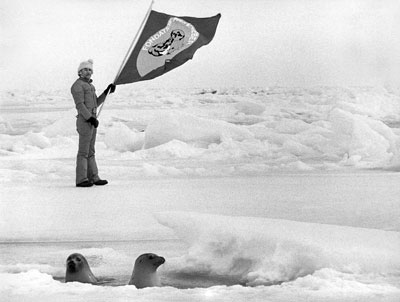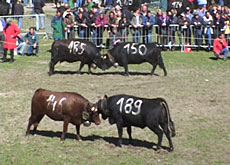Bullfighting is placed in the dock in Geneva

The bullfight: a traditional, spectacular ballet of death that pits man against beast, or a ritualised sadistic slaughter?
On Monday a case against bullfighting and its supporters in Spain, France and Portugal was brought before the International Court of Justice for Animal Rights at a show trial held in Geneva.
French President Nicholas Sarkozy and Spanish President José Luis Rodriguez Zapatero were two of the main personalities called to the dock, accused by some 60 European animal rights groups of supporting this “ignominious and degrading spectacle”.
The long list of accused also included bullfighting schools, promoters and breeders.
“As none of the indicted are present, we will continue with the trial in absentia,” said Swiss environmentalist and court president, Franz Weber, opening the hearing before a 100-strong audience.
Bullfighting continues to generate controversy, particularly in Europe, where it is practised in Spain, Portugal and southern France.
Fans claim it has become a deeply rooted European tradition and are pushing for bullfighting to become part of European cultural heritage. Earlier this month they organised an exhibition at the European Parliament in Brussels to drum up support.
But opponents say it is a dying sport watched by the over-50s and no tradition can ever justify cruelty to animals.
Protected to the hilt
“All the surveys carried out show that the vast majority of Spanish and French people are not interested in bullfighting; the truth is supporters are in the minority, which is reducing every year,” said prosecutor Caroline Lanty.
According to a 2006 survey, only 7.4 per cent of Spaniards are “very keen” on bullfighting and in France a similar survey found only five per cent “very much in favour”. In Portugal 50.5 per cent of people questioned last year said the practice should be banned.
“But in Spain there is a chasm between the people and those that govern them, as far as animal rights are concerned,” said Matilde Figueroa, a plaintiff from the Spanish non-governmental organisation, Friends of Animals.
“Bullfighting is protected to the hilt, identified by those in power as an inalienable symbol of our national identity, culture, history and art, all of which were regrettably true until a few years ago.”
Spanish campaigners say bullfighting activities receive public funds to the tune of €550 million (SFr892 million), including €15 million in EU subsidies for bull breeders.
“We must face the clear, cold reality: just 4.6 per cent of Spaniards [those who attend a bullfight more than once a year] are true fans, responsible for the continuation of this spectacle… and the bullfighting sector has some big, influential and powerful friends.”
“The French president and Prime Minister François Fillon have both regularly attended bullfights,” added Patricia Zaradny, president of the French Comité Radicalement Anti-Corrida.
“Traje de luces”
Next up were the experts: a child psychologist, a zoologist and a Spanish vet who presented his research into hormonal reactions in bulls during fights to validate the theory that bulls really do suffer.
Antonio Moreno, an ex-bullfighting fan, then retold his story of childhood obsession with the flamboyant matador costume, the “traje de luces” (suit of lights), and sudden conversion in his 30s when he finally saw a bull and not a “bad guy”.
And former Colombian matador, Alvaro Munera, who also “saw the light”, explained how in his new life as an animal rights campaigner, he tried “to make good all the crimes” he had committed in the ring.
But just when the trial was looking completely one-sided, up stepped Bernhard Fricke, a German lawyer – and animal rights campaigner – who presented the case for the defence.
“The main argument is that bullfighting has become part of national heritage and a European cultural asset,” he told the courtroom.
At the Minoan palace of Knossos in Crete there are frescoes dating back 4,000 years which depict men and women confronting and leaping over bulls, he said.
“Bullfighting is also extremely important to the economy of the Spanish, Portuguese and French regions in question,” said Fricke.
But the final guilty verdicts at the end of the afternoon were not unexpected.
“I created the court here in Geneva so that the animals have a way of defending themselves,” said Weber. “Each trial has a result – at least a moral one, as we talk about the problem.”
“It’s a symbolic trial, of course,” said his daughter, Vera Weber. “But it enables us to gets things moving. Many Swiss don’t even realise that there is bullfighting in France.”
“Bullfighting is slowly dying, but there are worrying elements this year,” she noted, referring to “huge sums of money” being invested in promotion and efforts to export it to Belgium, Morocco, Romania and Poland.
swissinfo, Simon Bradley in Geneva
Swiss environmentalist Franz Weber founded the United Animal Nations and the International Court of Justice for Animal Rights in Geneva in 1979. Based on the United Nations model, it currently has 120 member organisations worldwide.
Animal rights trials have been regularly held over the past 29 years, including issues such as the slaughter of baby seals in Canada, ivory traffic and the massacres of African elephants and the helicopter shooting of wild horses in Australia.
The court held trials against bullfighting in 1982 in Geneva and in 2003 in Brussels.
Bullfighting takes place in nine countries around the globe, including Spain, France and Portugal in Europe.
Bullfighting is illegal in some regions of Spain, including the Canary Islands. There are at least 42 bullfighting schools in Spain.
Despite popular belief outside Portugal, bulls in Portuguese bullfights are always injured with the “banderilhas” spikes and very often killed.
Although the French penal code recognises bullfights as “cruel acts and serious ill treatment towards animals”, bullfighting is allowed to continue in southern France as an “uninterrupted local tradition”. There are four bullfighting schools in France.
According to a Gallup poll, just over 7% of Spaniards consider themselves bullfighting fans and 82% of Spaniards aged 15-24 are not interested at all in bullfighting.
It is estimated that at least 40,000 bulls are killed by the bullfighting industry every year in Europe, and about 250,000 in the whole world.
Bullfighting activities are heavily subsidised in Spain by all levels of the Government. It has been estimated that over €530 million of taxpayers’ money is destined for the pro-bullfighting industry per year in Spain.

In compliance with the JTI standards
More: SWI swissinfo.ch certified by the Journalism Trust Initiative



You can find an overview of ongoing debates with our journalists here. Please join us!
If you want to start a conversation about a topic raised in this article or want to report factual errors, email us at english@swissinfo.ch.